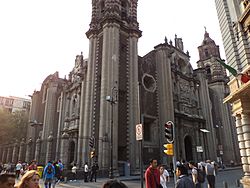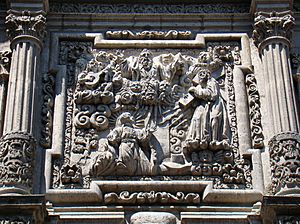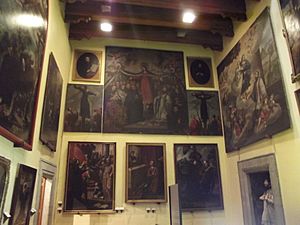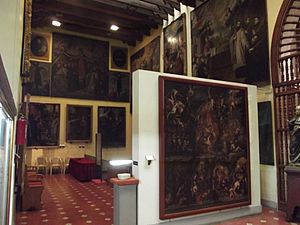Church of San Felipe Neri "La Profesa" facts for kids
Quick facts for kids Church of San Felipe NeriTemplo de San Felipe Neri |
|
|---|---|
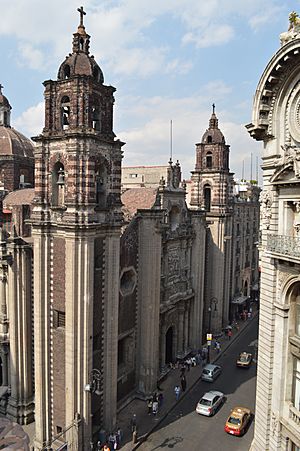
Facade of La Profesa
|
|
| Religion | |
| Affiliation | Roman Catholic |
| District | Roman Catholic Archdiocese of Mexico |
| Ecclesiastical or organizational status | Parish church |
| Year consecrated | 31 July 1610 |
| Location | |
| Location | Mexico City, Mexico |
| Architecture | |
| Architect(s) | Juan Pérez de Soto, Pedro de Arrieta |
| Architectural type | Church |
| Architectural style | Baroque, Neo-classical |
| Groundbreaking | 1597 |
| Completed | 1802 |
| Specifications | |
| Length | 55 metres (180 ft) |
| Width | 55 metres (180 ft) |
| Width (nave) | 30 metres (98 ft) |
| Materials | masonry and tezontle |
The Church of San Felipe Neri, often called "La Profesa," is a Roman Catholic church in Mexico City. Its name "La Profesa" means "the Professed house." It was started by a group of priests called the Society of Jesus (Jesuits) in the late 1500s.
This church is special because it shows a mix of old and new styles. It connects the simpler Baroque style of the 1600s with the very fancy Baroque style of the 1700s in Mexico.
You can find La Profesa at the corner of Madero and Isabel la Católica Streets. It's famous for being the place where important historical events happened. These include the "La Profesa Conspiracy," which helped Agustín de Iturbide become emperor, and the "Polkos Rebellion." More recently, discussions about making Juan Diego a saint took place here. The church also has a huge collection of old artworks from Mexico's best artists.
Contents
History of La Profesa Church
Building the First Church
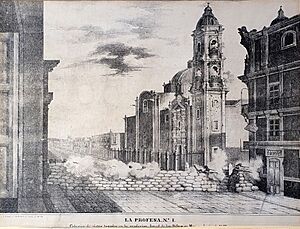
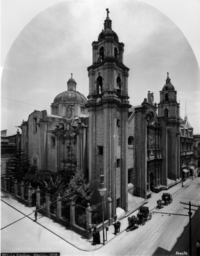
The first Jesuit priests arrived in Mexico in 1572. They bought land near the Zócalo in Mexico City to build their "Casa Profesa" (Professed House). Other religious groups already there disagreed, but the Jesuits won the right to build in 1595.
Wealthy people like Alonso de Villaseca helped pay for the first church. It was built between 1597 and 1610, with Juan Pérez de Soto as the architect. The church opened on July 31, 1610, and was called the "Church of the Professed House." People soon shortened the name to "La Profesa."
A big flood in Mexico City in 1629 almost completely destroyed this first church. Only a small part of the original roof remains today. The church was rebuilt in 1714. Gertrudis de la Peña helped pay for it, and Pedro de Arrieta designed the new building.
When the Jesuits Left and Returned
Over time, the Jesuits filled the church with many beautiful paintings and sculptures. But in 1767, the Jesuits were forced to leave Spain and all Spanish lands, including Mexico. La Profesa Church was then given to another group of priests, the Oratory of Saint Philip Neri. The church's name was changed to San José el Real, but people still called it "La Profesa."
Years later, the Jesuits were allowed to come back to Mexico. When they got the church back, they started building a "Casa de Ejercicios" (House of Spiritual Exercises). Manuel Tolsá, a famous architect, expanded this building and redecorated the church's inside. All this work was finished in 1802.
In 1855, a big celebration happened here for the declaration of the Immaculate Conception. A painting of this event is now in the National Museum of History. In 1861, new laws forced the monastery next to La Profesa to close. It was torn down in 1862 to make way for a new street.
La Profesa in Recent Times
In 1914, a serious fire damaged the church. It destroyed paintings in the dome by Pelegrí Clavé. Only one painting from 1861, showing the blessing of Creation, was saved. Later, the church hosted meetings for historians and others during the process of making Juan Diego a saint.
La Profesa was declared a historical monument in 1932 and again in 1980. The building has needed repairs because it slowly sinks into Mexico City's soft ground. Its front on Madero Street has also been restored. Today, it's a popular place for elegant weddings.
What the Church Looks Like
The church you see today was rebuilt in 1720 by Pedro de Arrieta. It replaced the one damaged by the 1629 flood. Only a small part of the original 1500s roof remains. The new church mixes styles from the 1600s and 1700s. This makes La Profesa an important example of architecture that influenced many buildings in Mexico City in the 1700s.
Newer features include an eight-sided window in the choir area with many decorations. The front of the church is set back from the street, with steps leading up to the main door. Older features include the cross-shaped floor plan with three main sections and an eight-sided dome.
The front of the church is covered in red tezontle stone with grey-white stone (cantera) details. Above the main door, there's a stone carving showing Christ appearing to Saint Ignatius of Loyola. Statues of Saint Gertrude and Saint Barbara stand next to it. The side door on Madero Street has a statue of Ignatius of Loyola.
Overall, the church is seen as a bridge between the simpler Baroque style of the 1600s and the very fancy Baroque style of the 1700s in Mexico.
The main altar you see today was made in 1799 by Manuel Tolsá in the Neoclassic style. It replaced an older altar. This altar is dedicated to Saint Philip Neri. Inside the church, the columns have a somewhat Gothic look. But the most striking part of the church's inside is its amazing art collection.
Near the entrance, there are statues by Cristobal de Villapando. These include the Virgin of the Rosary and the Vision of Saint Teresa. A later sculpture by Manuel Tolsá of the Immaculate Conception is in the right hallway. The church also has a special container called a reliquary that is said to hold pieces of Jesus's cross.
This church has a very large collection of old religious paintings. Only some of them are displayed inside the church itself. These include a painting of the Crucifixion by José Juárez above an altar. There's also "The Virgin of the Pópulo" by Juan Correa, and an old painting of Christ being crowned with thorns. One of the oldest and most valuable works is thought to be by Baltasar de Echave Orio, showing the Pentecost. The sacristy and the Chapel of the Virgin of Guadalupe also have valuable paintings. Most of La Profesa's art collection is shown in an art gallery next to the church.
La Profesa in Mexican History
In the 1800s and 1900s, several important historical events were linked to this church.
The La Profesa Conspiracy
In the early 1800s, during the Mexican War of Independence, a group called the "La Profesa Conspiracy" formed here. This group was led by Matías Monteagudo, who was in charge of the Casa de Ejercicios at La Profesa. They wanted a king to rule Mexico, not a republic, and they were against the Spanish Constitution of 1812. This group played a key role in helping Agustín de Iturbide become the emperor of Mexico after the war ended in 1821.
The Polkos Rebellion
Another political event connected to the church was the "Polkos Rebellion." This happened in 1847 when two groups of young, wealthy men refused to defend the city of Veracruz from the U.S. invasion. They were called "Polkos" because they were thought to support U.S. President James K. Polk. The name also came from their love of dancing the polka at fancy parties. It's said that these men held banquets in the church's courtyard during their uprising.
Art Collection at La Profesa
For much of its history, La Profesa was very important for art in Mexico. Both the Jesuits and the priests of the Oratory of Saint Philip Neri decorated the church and its buildings with many paintings and artworks. After the laws in the 1800s closed the monastery, the buildings next to the church were used for other things. The building known as the "Casa de Ejercicios" (House of Spiritual Exercises) eventually became an art gallery. This allowed the public to see the church's huge art collection. The gallery has works by famous artists like Cristobal de Villalpando, Juan Correa, and Pellegrí Clavé.
The art collection is divided into four rooms, each with a different theme.
Room One: Jesuit Art
The first room holds paintings that were ordered by the Jesuits before the church was given to the Oratory of Saint Philip Neri. One painting is thought to be by Alonso López de Herrero, showing Saint Francis Borgia. There are also two very large paintings showing Ignatius of Loyola and the death of Saint Francis Xavier. Another painting is of the Virgin of the Jesuits by Francisco Martínez. This artist was better known for gold-leaf work, like the altar in the Metropolitan Cathedral.
Room Two: Cardinal Newman Room
The second room is named after Cardinal Newman. It contains all the paintings linked to the Oratory of Saint Philip Neri. This room has portraits of eleven popes who had connections to this group of priests. Another series of paintings shows the life of Saint Philip Neri and is believed to be by Antonio de Torres. At the end of this room is a very large painting called "Patrocinio de San José a los felipenses" by José de Alcíbar from 1767. This painting was made to thank Saint Joseph because no member of the order died for seven years. The painting includes the faces of real members of the order from that time.
Room Three: Three Centuries of Mexican Painting
The third room is called "Three centuries of painting in Mexico." It features paintings by different artists from the 1600s to the 1800s. The display starts with a painting of Saint Ursula and her friends. Next, there are several paintings by Cristobál de Villalpando. These include "Scenes of the life of Joseph, son of Jacob," "Los Desposorios," and "Saint Jerome." There's also a portrait of archbishop Francisco de Aguilar y Seijas, which might be the only portrait this artist ever did. Even though it's not signed, the painting "Vision of Saint Vincent Ferrer" is also here and is thought to be by Villalpando.
This room also has three works by Juan Correa, like "La Dormición de la Virgen." Other paintings include the Prophet Elijah by Antonio Rodriguez and the Prophet Isaiah by Nicolás Rodríguez Juárez. One important painting is "Padre Eterno" by Pelegrí Clavé. This was the only work to survive a fire that damaged La Profesa Church in 1912. The left wall of the room has a large mural showing scenes from the Passion of Christ. Many artists, including Cristobál de Villalpando, worked on this mural.
Room Four: Casa de Ejercicios Collection
The last room has artworks that were likely part of the collection when the building was the Casa de Ejercicios. It starts with a portrait of Joaquín de Aldama, who gave a lot of money to help build this particular building. Next, there are several paintings showing scenes from the Passion of Christ. There are also two large works by Miguel Correa. These show the torments of hell and the final judgment of good and bad people.
See also
 In Spanish: La Profesa para niños
In Spanish: La Profesa para niños
- List of colonial churches in Mexico City
- List of Jesuit sites


